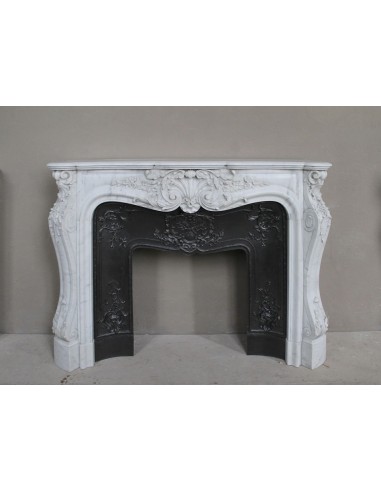This fireplace, as you will certainly have realized upon first seeing a few photographs of it, is a very, VERY important “piece,” If you promise not to start laughing, I will confess what my thoughts were upon first seeing it...
Promise?!
Well, my thought was this: If we were to mount this mantel at the Palace of Versailles, many of the 360 existing fireplaces in that little house would be seized with fierce envy.... What I am telling you is true, for the fireplaces in that palace were made by French master sculptors, and the French school of sculpture was born in earnest more or less in the second half of the 1700s (Louis XVI period), while our school of sculpture, on the slopes of the Apuan Alps, was born in 399 B.C., when the Romans conquered Veio, the capital of Etruria, and thus became the owners of the Apuan Alps (Louis, land of the Luni), where the most beautiful marbles in the world were found in enormous quantities.. And it was the Romans who gave life and great “impetus” to this school, for they were to build what would be THE IMPERIAL ROME.. In short, French sculptors were light years away from Italian sculptors in terms of quality, and so the fireplace I am presenting here IS, CERTAINLY, MUCH BETTER THAN THE FIREPLACES OF VERSAILLES. Let's give Caesar his due, right?!
This fireplace mantel was carved in Lunigiana (Italy) and probably in Pietrasanta, since so much quality could only be obtained there... And here we have not only the quality of the sculpture but also an ENORMOUS QUANTITY of the same sculpture, AS MUCH as I can't remember a'having ever seen..
In addition to this abundance of sculptural quality and quantity, we must also take into account, in evaluating this remarkable Work of Art, the Genius of the architect (I would put my hand on it that this is a Parisian architect from the École des beaux-arts..
This gentleman has combined the two most adept decorative elements in designing a fireplace: Flowers and shells.... Just take a little stroll through the images posted on our website to get confirmation of what follows.
And how did he combine them?
Perhaps the idea came to him thinking of the Centaur, half man and half horse, the fact is that in this fireplace (A UNIQUE THING IN THE WORLD) the classic shell is born and, as it grows, it changes into a flower, leaf, shrub, in short, it becomes a real “union” of the two decorative elements (flowers and shells) most common in the world of fireplace sculpture.
Large quantities of flowers and leaves erupt from the shell and are distributed over almost every surface of the fireplace itself.. These flowers are, intentionally, wild flowers, combined with a multitude of daisies, which represent a tribute (that could not be overlooked) to King Louis XIV, the Sun King.
ULtime more “practical” notes:
A) This mantel also has carved squares on the sides using the fluting technique (which is very rare and reserved for really VERY important fireplaces);
B) Its structure (the thicknesses of its marbles, in short) is VERY strong (about twice as strong as a normal fireplace), another thing that does not hurt.
PARISIAN FIND, VERY ITALIAN SCULPTURE, PERFECTLY PRESERVED, NAPOLEON III PERIOD.
082 AG OUTSTANDING LOUIS XV FLORAL FIREPLACE MANTEL IN WHITE CARRARA MARBLE PROVIDED WITH ITS ORIGINAL CAST IRON INSERT
Louis XV
€25,500.00
No tax
SHARE ON:
Description
Reviews (0)
No reviews












































































































